Note- I wrote a bit of this while I was waiting for a highway to re-open…
It looks like I have offline time for some slow blogging. I am writing this from the front seat of my car, stuck in a highway closure on Arizona Highway 87, whose nickname is the “Beeline Highway”. The bees are not moving fast today, there is an accident up ahead, and the highway is a parking lot of strangers thrown together. There is the usual flitting around, craning necks, and people who don’t know each other talking like they don’t.
There is no spot to do a turn around on this mountain highway, and what else can one do? As much as I might complain, I am guessing someone up ahead is having a much much worse day, likely the worse of their life.
While here I have time to reflect on the experience a few days ago of attending the Program for the Future event in San Jose, designed to honor the 40th anniversary of a computer historic event known as the “Mother of all Demos” (I prefer to to acronymize it like someone else did in a presentation as “MOAD”).
If you have never seen the video of what Doug Engelbart and his SRI team did in San Francisco, stop now and go watch the video. Watch it twice, or more…
As I said in our presentation, back in 1968 I missed the Mother Demo; I was only 5 and was likely watching the Flintstones instead. But I wonder (and have been asking others) what is happening today in our tech world that might have such an impact. Or what someone who is 5 now might be seeing 40 years from now.
What this live demo did was demonstrate almost countless features of the modern computer interface in a time when computing meant mainframes, punch cards, and teletypes. Engelbart’s peers saw no reason for a computer screen– but I think he showed them wrong.
Engelbart seems most credited for invention of the mouse (which was actually co-created with Bill English), but when you look at the demo, that is not even a significant aspect of the NLS system. He had two way video conferencing (al a Skype). Live co-editing of documents (Google Docs), cut and paste of text, a flexible menu structure, and more.
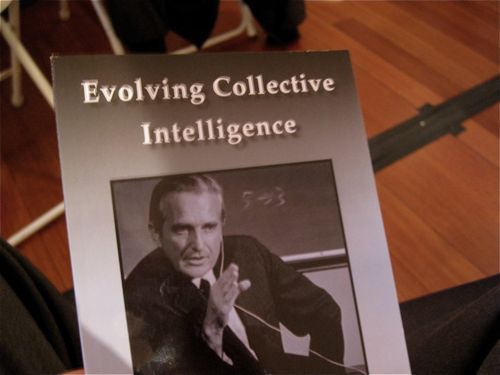
I am always curious about the meaning of the chalkboard in this photo of what is written “5->3”
The Program for the Future was meant however to convene people around Engelbarts concepts of collective intelligence, which again he outlined long before it reached buzzword status about a year or two ago.
The hopes for the event were to stimulate research, development, advancement of these ideas, and there were certainly plenty of heavy hitters in the crowd.
Yet to me, it seems awfully early to begin formulating CI as something concrete, it is all so emergent. I left with no clearer idea of what it was, although I thought we did a good job last year describing it in the NMC Horizon Report:
Two new forms of information stores are being created in real time by thousands of people in the course of their daily activities, some explicitly collaborating to create collective knowledge stores like the Wikipedia and Freebase, some contributing implicitly through the patterns of their choices and actions. The data in these new information stores has come to be called “collective intelligence” and both forms have already proven to be compelling applications of the network. Explicit knowledge stores refine knowledge through the contributions of thousands of authors; implicit stores allow the discovery of entirely new knowledge by capturing trillions of key clicks and decisions as people use the network in the course of their everyday lives.
I found at this event people focused almost completely on the explicit forms, while I think the more intriguing stuff is in the implicit variety, such as digitizing texts via captchas or the recent tracking of flu outbreaks via analysis of Google search activity.
At this event, many people yearned for definitions (yawn). And then it seemed like we were trying to do collective intelligence for the sake of doing collective intelligence. Thomas Malone’s categorization of Mapping the Collective Intelligence as a Genome was an interesting approach, especially for the description of Garry Kasparov’s Chess Game Against the World which took 4 months to play.
By far, the most fascinating presentation was Hiroshi Ishii’s Tangible Bits which blew the doors off of what we think of as interfaces. The crowd was on edge with the videos of the I/O History Brush, an actual brush like input device that recorded colors or even video from the real world as paintable textures. The excited responses of kids using this (w/o any apparent referring to user manuals) and being creative was mind blowing.
At the conference hey tried to make a lot of use of “clickers” for audience response, but to me, the execution of it was lukewarm as most of the things we got to respond to were raw ideas, vaguely worded, and as detailed as “the sky is blue”. The guy running it did impress with the live cross correlations he did with demographic responses, but I did not see much value in what were statements like “we should solve complex problems” or “collective intelligence is good” (those were made up but on par with the caliber of statements). I started gaming it with rogue responses (yes, my demographic is I was born in Antarctoca).
And frankly I saw a lot of typical human behavior of people there to push their own agendas or projects, making it seem more like collective ego-gence).
Well, but, we were there as NMC representing what Doug has identified as a model of his concept of a “networked improvement community”, so I guess we were guilty as we talked about us– but our message was, NMC is not about the people who work there, but the people who participate in what we do. We had the fortune to spend a morning with Doug back in December 2006 at one of the NMC Board meetings, and then, in his mid 80s, he was still so sharp.
I convinced my colleagues to skip the slide deck approach and we settled on a conversational style approach, in front of a slide show of images showing the history of NMC flashing behind us. We sort of had a script:
They cut us a bit short of our 20 minutes, but I think we got the message out about NMC. I did record the audio from the session and just tonight remixed the slide show with our audio. Since the original was planned for 20 minutes, I inserted a few clips of Doug’s voice in the Mother Demo.
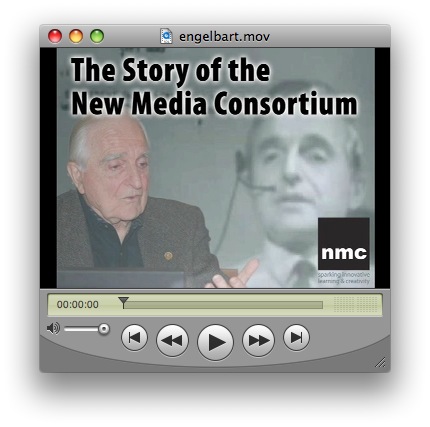
The NMC Story [40.9Mb QuickTime]
I’ve thought back to the kids in Hiroshi’s demo and some later experiences I had in Reno following this trip visiting Brian Crosby’s 6th grade class, and find myself more convinced we need to tap back into the natural curiosity and optimism of kids– and one attribute I find lacking is the reluctance by many to openly share. It is such a natural thing at 5 years old. How do we grow older, supposedly wiser, yet more fearful and stingy. I really do not grok, grasp why most presentations I saw at the conference had a cull copyright symbol on them.
One thing that was pulled off quite nicely, was the Second Life component of the conference organized by The Tech museum — not only providing streaming video into the sim (looks like they used ChatBridge too) but also bringing back the Sl audience inputs to the live event. They also had upwards of 200 on a ustream of the event.
I missed half of Steve Wozniak’s lightspeed talk but heard there were some interesting metaphors.
We then had a great opportunity to see the special Leonardo Da Vinci exhibit 500 Years into the Future at The Tech Museum of Innovation.
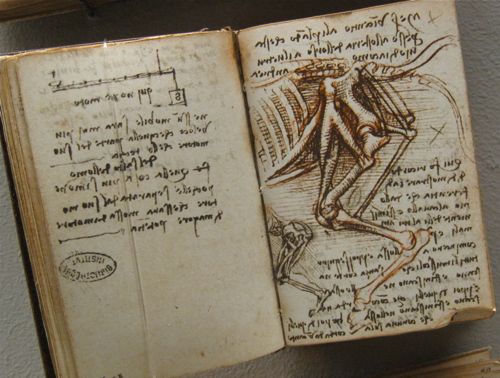
And then an evening at Adobe with two computer pioneers of this era, Alan Kay and Andy van Dam. I had a great seat right behind Engelbart (and next to Gardner Campbell)
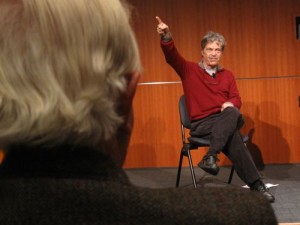
Both Kay and van Dam seem pessimistic about the current state of technology realizing Engelbart’s vision and capability of his NLS system. Kay derides the cumbersome and speed eating browsers which to him are throttling the capability of modern computers. He is worried that we are all too eager to become wizards at Guitar Hero than to really learn the guitar. Van Dam speculated the web as we know it is only a fraction of Engelbart’s vision.
I appreciate their perspective, and am standing on scrawny legs to disagree, but I do. For myself, I am not seeking a pure computer scientist experience on the machine; what I find is the connectivity of this web un heralded in history, and we are only seeing its undermining of the status quo in politics, publishing, (education>). What else is significant, is the their dream machine of 1968 was for the hands of a few technical savvy individuals, and I do not see the user generated content figuring so prominently in the NLS.
But who am I?
AT the end of the Adobe event, someone handed Doug a copy of the morning’s S.F. Chronicle, which featured an article on Engelbart, about 40 years too late:

The next day brought a morning of more sessions on Collective Intelligence with the location moved to Stanford University. I found this portion even less valuable, with 2 hurried rounds of World Cafe on very vague topics “What excited you most about Collective Intelligence” and then some panel discussion with journalists.
The afternoon was a shift to another separate but related event, the recognition for Engelbart from SRI, the company where all the work took place. This was a larger event in a big hall at Stanford, opening with a panel of Doug’s SRI colleagues who were actually there at the Mother of All Demos… I snagged a third row seat as to get good photos.
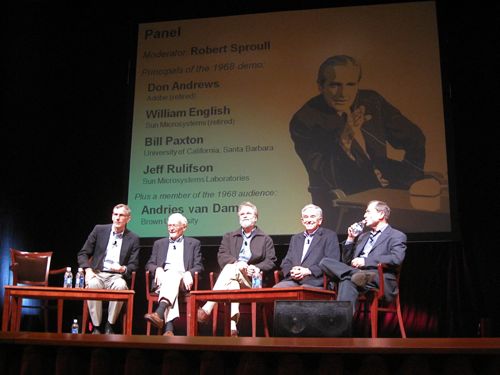
These guys are all still very vibrant and act almost as excited as they just have been 40 years ago. One quip I recall was that the system did crash once, but the reboot time was so click, that there is just one frame of the video where if you slow it down, you can see the crash message. Try that on Vista.
Then came the audience Q&A– I asked for historical context, what were some of the other tings demo’ed at this same conference that were “out mothered”? Someone managed to rush on stage with an old program to read a few of the titles off.
The next session was a conversation with Bob Taylor, who was at NASA and the Defense Department and providing the support and financial backing to SRI to design and create the ARPANET, the first internet, so as host John Markoff said, this was truly the “father” of the internet.

And then Alan Kay closed again with a masterful slideless, impassioned message for us to get back to Engelbart’s vision and to take up the challenge of our failing schools and ask that more scientists become active in invigorating schools.

It was humbling to me among the wizards who started the first tubes and the machines we enjoy today. I am hoping some of their luster has rubbed off on the rest of the audience…




Let me tell you, the people in that accident really did have a bad day. My hubby was one of the first medical people on site. We drove past within a minute or two after the accident happened and stopped to help. We were there for an hour and a half before we finally left because they had flown one of the passengers down to the Valley.
Alan,
Thanks for sharing the experience with us. I spent two years with Doug and built the first version of HyperScope prototype (that is just a bit of background).
There are many ideas of Doug (Co-evolution of Human and Tools system, Improving Improvement through NICs, Dynamic Knowledge Repositories and his concept of a KWAC – Knowledge Workshop Architect). I think beyond hypertext and computers, when you watch him work with NLS, you are amazed at how much he can do with so little. And that NLS just worked against a simple text database.
I think there are many exciting possibilities. Many of them are at a very conceptual level. I am looking forward to seeing a lot more after this conference. Doug’s admirers (me being one of them) went off to do our own things in life. However, once you meet and spend time with him, your life changes (ever so subtly). Your thinking vocabulary gets altered a bit. I hope some of that happened at the conference.
The thing that will stay with me for a long period is the concept of a meta improvement community (the one he refers to as meta NIC). A few of those would alter this world.
@Dorai – Thanks for sharing your experience. I do wonder how an NLS would work for say, 1 billion people?
As far as the meta NIC, we were there was Doug has referred tp NMC as an example of a NIC… I think the meta NIC is really the collective (!) or connective (?) one of the web.
It’s great to read how you experienced the event alongside Gardner’s thoughts about the same. Maybe there really is something to the tiny amount of progress that it seems we’ve made. It certainly sounds like it was a fantastic program, even if I have little idea *still* what Collective Intelligence is fundamentally about despite reading a few books and a lot of web writing. For now, for me, it remains one of those emergent ideas that only super geniuses, evil and otherwise, seem to be able to predict much about.
All I can say is “Wow!” Your title is spot on, you truly were amongst the Wizards. You simulatenously name at least 6 of my digital heroes in one post. Lucky dog!
I agree with your critique–but as you make clear, the highs far outweighed the lows, and the highs were beyond stratospheric. To meet Doug Engelbart and tell him thanks–to be sitting next to you and Rachel, just behind Doug, as Alan and Andy held forth, to see Alan hug Doug just before that talk, and really the entire celebration in Memorial Auditorum–it’s beyond description for me, and I’ve been suffering very intense withdrawal pangs ever since.
I need to blog….